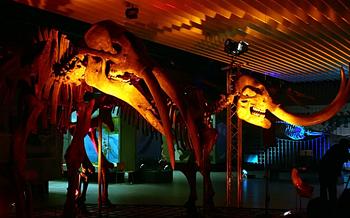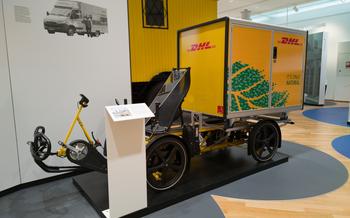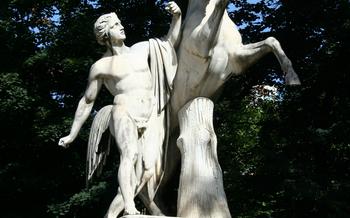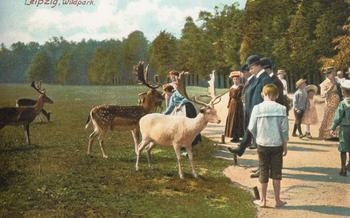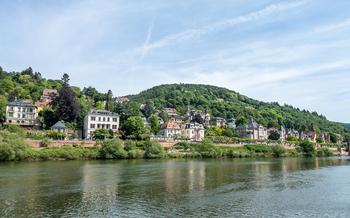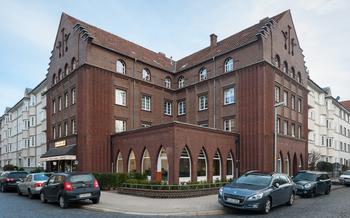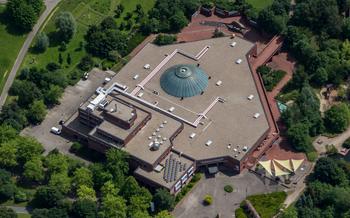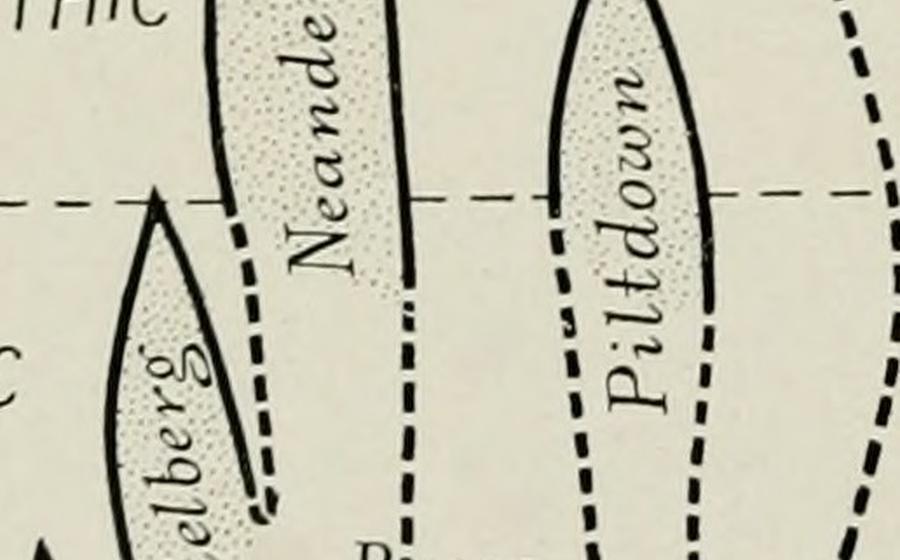
The University of Heidelberg Museum of Zoology
- The Antiquity of the Museum
- Navigating the Museum
- The Zoological Collection
- Impressive Fossil Displays
- Interactive and Educational Exhibits
- Research and Conservation Initiatives
- Temporary Exhibitions: A Journey through Diverse Themes
- Guided Tours and Workshops: Exploring the Museum with Experts
- Educational Programs for Children
- Accessibility for All
- Museum Shop and Café
- Location and Transportation
- Hours of Operation and Admission Fees
- Photography and Videography
- Insider Tip: Uncover Hidden Zoological Treasures
The Antiquity of the Museum
The University of Heidelberg Museum of Zoology holds a rich history dating back to the 18th century, when it began as a natural history collection. Over time, it has evolved into a renowned zoological museum, housing a vast array of animal specimens that hold significant scientific and cultural value. The museum's historical collection forms a cornerstone of its identity, showcasing the dedication and passion for the natural world that have driven its development throughout the years. This collection serves as a testament to the museum's commitment to preserving and sharing the wonders of zoological diversity with the public.
Navigating the Museum
The University of Heidelberg Museum of Zoology is a sprawling complex, housing an extensive collection spread across multiple floors. To ensure a smooth and enjoyable visit, it's recommended to allocate sufficient time to explore the various exhibits. The museum's layout is well-organized, with clear signage guiding visitors through the different sections. Upon entering, visitors are greeted by a spacious foyer that provides an overview of the museum's offerings. From here, they can choose to follow a suggested route or embark on a self-guided tour. The ground floor primarily showcases exhibits on mammals and birds, with impressive displays of taxidermied specimens and interactive exhibits on animal behavior and adaptations. The upper floors house exhibits on other taxonomic groups, including reptiles, amphibians, fish, and invertebrates. To make the most of your visit, plan to spend at least two to three hours exploring the museum's diverse collection.
The Zoological Collection
The museum boasts a remarkable collection of animal specimens, representing a diverse array of taxonomic groups, from tiny insects to majestic mammals. Among the highlights of the collection are the impressive array of birds, with over 8,000 specimens representing species from around the world. Visitors can marvel at the intricate plumage and adaptations of these feathered creatures, gaining insights into their behavior and habitats. The museum also houses a significant collection of mammals, including skeletons, taxidermied specimens, and live animals. From majestic lions and tigers to delicate bats and rodents, these exhibits showcase the incredible diversity of mammalian life. Reptile and amphibian enthusiasts will find a fascinating array of species, from sleek snakes and colorful frogs to ancient turtles and salamanders, each providing a glimpse into the remarkable adaptations and survival strategies of these ectothermic creatures. The museum's collection extends beyond vertebrates, encompassing a vast array of invertebrates, including insects, spiders, mollusks, and crustaceans. These often-overlooked creatures play crucial roles in ecosystems and offer a unique perspective on the diversity of life on Earth.
Impressive Fossil Displays
Delve into the captivating world of fossils at the University of Heidelberg Museum of Zoology. Journey through time and discover the remarkable diversity of life that once roamed our planet. Witness the awe-inspiring remains of extinct species, including the towering skeletons of dinosaurs, the intricate shells of ancient marine creatures, and the fossilized footprints of long-gone mammals. These remarkable specimens provide a tangible connection to Earth's rich history and the incredible evolutionary journey that has shaped the world we see today.
The museum's fossil collection extends beyond dinosaurs, encompassing a vast array of extinct organisms. Explore the fossilized remains of ancient fish, amphibians, reptiles, birds, and mammals, each offering a unique glimpse into the diverse ecosystems that have existed throughout Earth's history. Learn about the remarkable adaptations and specializations that allowed these creatures to thrive in their respective environments.
Through the study of fossils, scientists have gained invaluable insights into the evolution of life, the interconnectedness of species, and the dynamic processes that have shaped our planet. The University of Heidelberg Museum of Zoology's fossil collection serves as a testament to the power of paleontology and its contributions to our understanding of the natural world.
Interactive and Educational Exhibits
The University of Heidelberg Museum of Zoology captivates visitors with its array of interactive and educational exhibits that bring the wonders of the animal kingdom to life. Engage in hands-on experiences that allow you to delve into the fascinating world of animal behavior, adaptations, and conservation efforts. Discover how animals communicate, how they have evolved to survive in diverse habitats, and how they contribute to the delicate balance of our planet's ecosystems. These interactive displays not only entertain but also impart valuable knowledge, fostering a deeper understanding and appreciation for the diverse species we share our world with. Immerse yourself in the interactive wonders of the University of Heidelberg Museum of Zoology and embark on a journey of discovery that will inspire and educate.
Research and Conservation Initiatives
The University of Heidelberg Museum of Zoology is not merely a repository of specimens but also an active hub for scientific research and conservation endeavors. Its team of dedicated researchers collaborates with institutions worldwide, engaging in cutting-edge projects that advance our understanding of the animal kingdom. Their work focuses on various aspects of zoology, including biodiversity, ecology, evolution, and conservation biology.
A notable initiative undertaken by the museum is the Biodiversity Research Center, which plays a crucial role in documenting and preserving the region's rich biodiversity. Researchers conduct field studies, collect data, and contribute to conservation efforts aimed at protecting endangered species and their habitats. The museum also houses a state-of-the-art DNA laboratory, enabling scientists to conduct genetic analyses and contribute to the field of molecular ecology.
Moreover, the museum actively participates in conservation breeding programs for endangered species. By collaborating with zoos and conservation organizations, they aim to maintain viable populations of threatened animals and support their reintroduction into their natural habitats. This work not only contributes to the preservation of biodiversity but also raises awareness about the importance of conservation efforts among the public.
Temporary Exhibitions: A Journey through Diverse Themes
Complementing its permanent collection, the University of Heidelberg Museum of Zoology also presents a dynamic program of temporary exhibitions that delve into specific themes or topics related to the animal kingdom. These exhibitions showcase innovative research, highlight emerging issues, or present unique perspectives on the world of animals.
Past exhibitions have covered a wide range of subjects, from the intricate adaptations of deep-sea creatures to the conservation challenges facing endangered species. Visitors have had the opportunity to witness captivating displays of rare and exotic animals, learn about the latest scientific discoveries, and engage with interactive exhibits that bring the natural world to life.
These temporary exhibitions offer a fresh and ever-changing experience for visitors, providing an opportunity to explore new dimensions of zoology and gain insights into the fascinating diversity of the animal kingdom. Whether you are a seasoned museum-goer or a casual visitor, the University of Heidelberg Museum of Zoology's temporary exhibitions are sure to captivate your imagination and leave you with a lasting impression.
Guided Tours and Workshops: Exploring the Museum with Experts
To enhance your visit to the University of Heidelberg Museum of Zoology, consider joining one of the guided tours offered by the museum. These tours are conducted by knowledgeable and experienced guides who provide insightful commentary and explanations about the exhibits. They can answer your questions, share fascinating stories, and help you understand the significance of the specimens on display.
Guided tours are available for groups of all sizes and can be tailored to specific interests or age groups. Whether you're a family with young children, a group of students, or a general visitor, there's a tour that will suit your needs. The museum also offers workshops and educational programs throughout the year, providing hands-on experiences and in-depth learning opportunities for visitors of all ages. These workshops cover a wide range of topics, from animal behavior and ecology to conservation and biodiversity. By participating in a guided tour or workshop, you'll gain a deeper understanding of the museum's collection and the important work it does in the field of zoology. So, be sure to check the museum's website or inquire at the information desk for available tour and workshop schedules during your visit.
Educational Programs for Children
The University of Heidelberg Museum of Zoology recognizes the importance of fostering a love for nature and scientific curiosity in young minds. To this end, the museum offers a range of educational programs specifically designed for children. School visits are a popular option, allowing teachers to incorporate a hands-on learning experience into their curriculum. During these visits, students can engage with interactive exhibits, participate in guided tours, and even handle some of the museum's specimens under the supervision of trained educators.
For families looking for a fun and educational day out, the museum offers workshops and family-friendly activities on weekends and during school holidays. These activities are designed to be both enjoyable and educational, allowing children to learn about the animal kingdom through hands-on experiences. Whether it's creating their own fossil casts, examining animal specimens under a microscope, or participating in a scavenger hunt through the exhibits, there's something for every child to enjoy.
The museum's knowledgeable staff is always on hand to answer questions and provide insights into the exhibits, ensuring that children leave with a deeper understanding of the natural world and a passion for zoology.
Accessibility for All
The University of Heidelberg Museum of Zoology is committed to providing an inclusive and accessible environment for all visitors. The museum offers various accessibility features to ensure that visitors with disabilities can fully enjoy their experience. Wheelchair ramps and elevators are available throughout the museum, making it easy for visitors to navigate all floors and exhibits. Additionally, the museum provides audio guides for visitors with hearing impairments, allowing them to learn about the exhibits at their own pace. The museum staff is also trained to assist visitors with disabilities and answer any questions they may have. With these accessibility measures in place, the University of Heidelberg Museum of Zoology strives to create a welcoming and educational experience for all visitors.
Museum Shop and Café
The University of Heidelberg Museum of Zoology offers a well-stocked museum shop where visitors can purchase a variety of souvenirs, books, and educational materials related to the museum's collection and exhibits. From plush animal toys and replicas of fossils to field guides and scientific publications, the shop caters to visitors of all ages and interests.
For those looking for a quick bite or a refreshing drink, the museum also features a cozy café. Located within the museum premises, the café provides a relaxing space for visitors to unwind and enjoy a variety of snacks, sandwiches, and beverages. Whether you're looking to grab a quick cup of coffee or indulge in a leisurely lunch, the café offers a pleasant ambiance and a convenient option for visitors to refuel during their visit.
Location and Transportation
The University of Heidelberg Museum of Zoology is conveniently situated at Im Neuenheimer Feld 234, 69120 Heidelberg, Germany. Its proximity to various transportation options makes it easily accessible for visitors.
To reach the museum by public transport, visitors can take the bus or tram. Bus lines 33 and 34 stop directly outside the museum, making it a hassle-free option. Alternatively, tram lines 21 and 24 stop nearby, requiring a short walk to reach the museum.
For those arriving by car, the museum offers ample parking spaces. The parking area is adjacent to the museum, ensuring a seamless transition from the car to the museum's entrance.
Whether you choose to arrive by public transport or car, the University of Heidelberg Museum of Zoology is easily accessible, allowing visitors to delve into the fascinating world of zoology without any hassle.
Hours of Operation and Admission Fees
The University of Heidelberg Museum of Zoology welcomes visitors during specific hours of operation to ensure a comfortable and organized experience. Plan your visit accordingly to avoid disappointment. The museum typically operates during the week, with closures on certain days. Double-check the museum's website or contact them directly for the most up-to-date information on their schedule.
Admission fees are applicable for entry into the museum. Regular admission tickets are reasonably priced, offering access to all exhibits and displays. However, the museum offers reduced rates for students, seniors, and families, making it accessible to a wider audience. Keep an eye out for special promotions or discounts that may be available during certain periods.
Remember, the museum's collection is extensive, and it's easy to spend several hours exploring the exhibits. Allocate sufficient time to fully appreciate the wonders of the animal kingdom on display.
Photography and Videography
The University of Heidelberg Museum of Zoology encourages visitors to capture their experiences through photography and videography. However, to ensure the preservation of the exhibits and the comfort of other visitors, certain guidelines must be followed. Flash photography is strictly prohibited, as it can damage delicate specimens and disturb the tranquil atmosphere of the museum. Visitors are also requested to be mindful of other guests and avoid blocking exhibits or causing disruptions while taking photos or videos. By adhering to these guidelines, visitors can document their visit while respecting the museum's collection and the rights of others.
Insider Tip: Uncover Hidden Zoological Treasures
As you wander through the museum's exhibits, keep an eye out for hidden gems that may not be immediately apparent. One such treasure is the "Cabinet of Curiosities," tucked away on the third floor. This room houses a fascinating collection of oddities and wonders, including preserved specimens, antique scientific instruments, and taxidermied animals. It's a glimpse into the history of natural history and a testament to the museum's commitment to preserving our planet's biodiversity. Take your time exploring this hidden gem, and you'll be rewarded with a unique and unforgettable experience.


